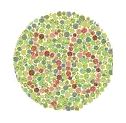
On the retina of the eye photoreceptors known as cones are of several types, each type sensitive to a certain color. Individual cones are normally selective for red, green, or blue light in the human eye. Colorblindness occurs when the amount of pigment sensitivity per cone is reduced, or when one or more of the three cone systems is absent. It is a misconception that a colorblind person sees only in shades of gray or in black and white — a condition that is possible, but is extremely rare. The most common types of colorblindness — 99% of all colorblindness — are "red/green" — an inability to distinguish some or all reds from some or all greens. Another type, "yellow/blue," is so rare that there is no test for it.
The most commonly used test to determine whether and how a person is colorblind was developed by Dr. Shinobu Ishihara. Although professionally performed by ophthalmologists and optometrists, a curious person can find these tests on the Web, and self-assess.
When colorblindness occurs, it is almost always at birth, a result of genetic inheritance. Various researchers have found that colorblindness occurs in about 10% - 12% of males of European genetic heritage and about one-half of 1% of females — although inherited more often by males, it is produced by a gene passed along by females (mothers). (ArtPage has not found research on other genetic groups.)
![]()
| Name of deficiency | Description |
|
Protanomaly 1% of males |
Protanomaly is "red weak." Any redness seen in a color by a normal eyes is seen more weakly by protanomalous eyes, both in terms of its saturation and its brightness. Red / orange / yellow / yellow-green / green appear somewhat shifted in hue towards green, and all appear paler than they do to normal eyes. The redness component that normal eyes see in violet or purple colors is so weakened for the protanomalous observer that he may fail to detect it, and therefore sees only the blue component. Hence, to him the color that the normal eye perceives as violet or purple may appear to be a shade of blue. Under poor lighting conditions, such as those drivers encounter in bright sunlight or in rainy or foggy weather, it is possible for protanomalous drivers to mistake blinking red traffic lights from blinking yellow or amber ones, or to fail to distinguish green traffic lights from the various "white" lights of other lamps. |
|
Deuteranomaly 5% of males |
Deuteranomaly is "green weak." Difficulty in distinguishing between colors in the red / orange / yellow / green region of the spectrum. These colors appear somewhat shifted towards red — making it difficult to tell violet from blue. Protanomalous and deuteranomalous people have very few problems performing tasks that require normal color vision. Some may not even be aware that their color perception varies from normal. Their only trouble is likely to come in trying to pass a color vision test. |
|
Dicromasy subdivided into protanopia and deuteranopia 2% of males |
Dicromansy reduces discrimination between red / orange / yellow / green. People experiencing Dicromasy are likely to be very aware they have a color vision problem and it can effect their lives on a daily basis. |
|
Protanopia 1% of males |
Protanopia reduces the brightness of red / orange / yellow compared to normal. This dimming can be so pronounced that reds may be confused with black or dark gray, and red traffic lights may appear to be extinguished. They may learn to distinguish reds from yellows and from greens primarily on the basis of their apparent brightness or lightness, not on any perceptible difference of hue. Violet, lavender, and purple are indistinguishable from various shades of blue because their reddish components are so dimmed as to be invisible. |
|
Deuteranopia 1% of males |
Deuteranopia reduces discrimination between red / orange / yellow compared to normal, but without the dimming experienced in protanopia. It also reduces discrimination between violet / lavender / purple / blue, again without the dimming. |
There is no treatment for colorblindness, nor is it usually the cause of any significant disability.
It can be challenging to individuals
affected by colorblindness, nevertheless. Those who are colorblind
find it difficult or impossible to perform certain activities.
People who are red/green colorblind, for instance, may have difficulty
distinguishing between traffic signals that indicate "stop"
and "go," so they must rely upon the conventions
for the placement of such
lights. Those who are colorblind have significant challenges in
the art world. Colorblind artists
find they must look more carefully than others at the labels on
their colors. And they rely even more on others' descriptions
of their works in order to know how their audience
will perceive their work.
An artist typically relies on others' descriptions of the artist's
work anyway, however, because artists are wise to determine whether
the audience sees what the artist thinks it sees, in order to
make changes as the artist thinks best.
![]()
Most colorblind people compensate well for their defect and may even discover instances in which they can see things that elude normal-sighted persons. One anecdote to support this is that some colorblind soldiers have been able to identify camouflage designs that fool soldiers who are not colorblind.

The Ishihara Test for Colorblindness.
One of
the several images Dr. Shinobu Ishihara designed as part of his
test for colorblindness. You can distinguish certain reds from
certain greens if you can see the number 56 in this portion of
Ishihara's test. Follow the link above in order to see more of
the entire test.
Color Vision Testing Made Easy, by Dr. Terrace Waggoner, distributed by Bernell.
Also see night blindness (nyctalopia), nuance, RGB (red green blue), ultraviolet, xenophilia, and xenophobia.
https://inform.quest/_art
Copyright © 1996-![]()